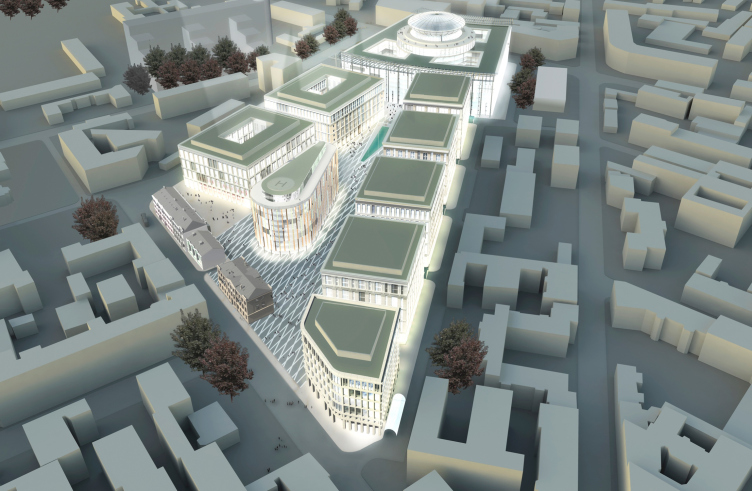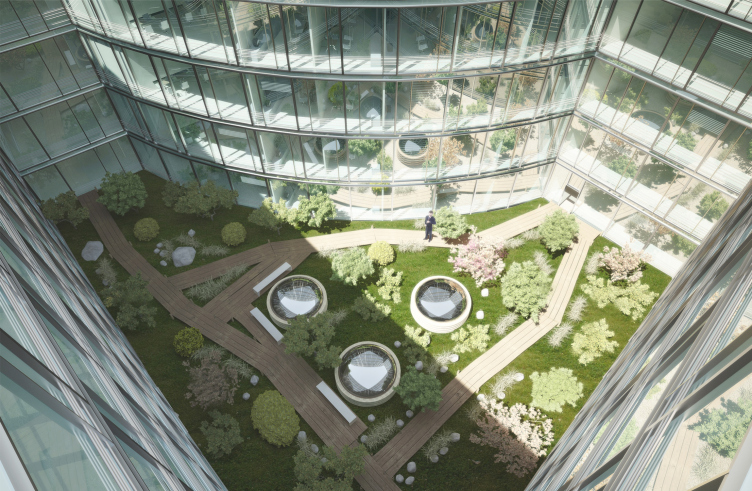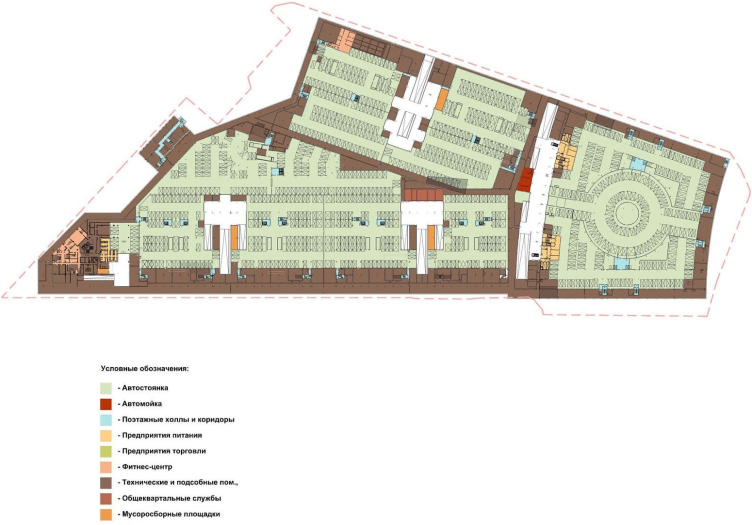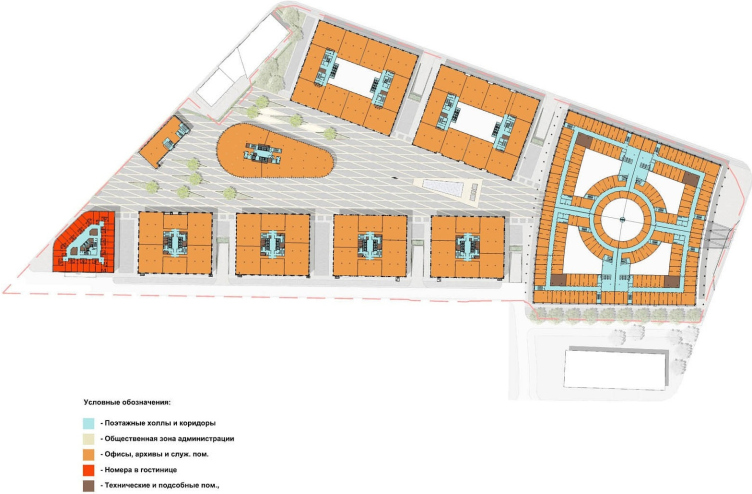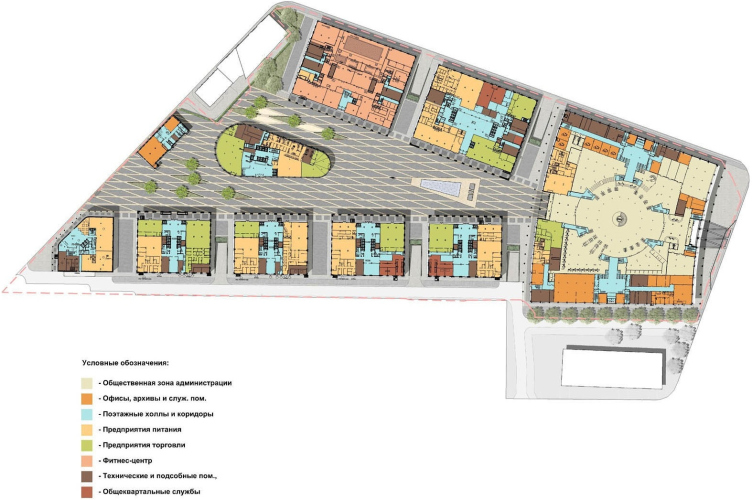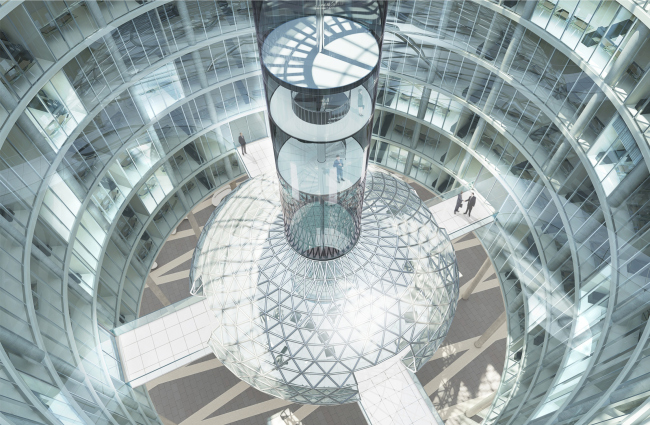
Nevskaya Ratusha. Atrium
The concept of the administrative and public/business complex "Nevskaya Ratusha" has been jointly developed by the companies "Eugene Gerasimov and Partners" and nps tchoban voss that won it in the closed international tender back in 2007. The completion of the construction of a 9-building complex that was meant to combine the functions of the "New Smolny" and a large business center was already scheduled for the year of 2010. The lengthy process of getting all the necessary approvals, however (the construction permit was only issued two years later), coupled with the crisis of 2008, significantly pushed the completion dates. Some adjustments had to be made upon a more detailed examination of the land site that was allotted for the construction. Presently, the implementation of the first construction phase is in full swing - this, apart from the administrative building, includes two buildings of the business center. The latter are due to be launched into operation this fall. As far as the completion of the other six buildings is concerned, their future is still uncertain.
Previously, this territory, located in the very heart of Saint Petersburg, in the immediate vicinity of the Smolny Palace and the Uprising Square, hosted Tram Park #4 and the plant named "Severny Uksus" ("Northern Vinegar" - translator's note). Due to the new construction project, all the existing buildings were supposed to be taken down. However, as early as in July 2008, Committee on State Control, Use and Protection of Historical and Cultural Landmarks discovered in the Degtyarny Alley three heritage buildings, two of which - the former administrative building and the front building of the Rozhdestvensky park, built back in 1912 - were recognized to be monuments of architecture. It was decided that the front building would be partially kept and included into the complex under construction. Thus, the nine already-planned buildings got a tenth one - three stories high and meant predominantly to serve administrative purposes. According to the project, it will be restored and modified to fit the needs of the complex.

The city hall and the business center as viewed from the public square.
Some changes were also made to the positions of the other buildings on the land site, even though the radial planning was still there. The trapeze-shaped volume of the city hall was also preserved - it is situated in the eastern part of the venue and is covered with an imposing dome executed in the shape of a translucent oval cup. The main glazed facade of the building faces the Novgorodskaya Street. The stone pilasters and columns that support the glass awning, and the horizontal "stitch" of the cornice belts look like but a temporary intrusion into the seamless glass of the facade. The theme of the abundant glazing is picked up and developed by the outdoor blinds and the double light-reflecting glazing that serve to protect the inner premises from the excessive sunlight.

Administration building as viewed from the Novgorodskaya Street.
The main entrance to the building is provided from the Novgorodskaya Street - it leads into a multi-height atrium, whose "visiting card" will be the crystal ball of the TV studio hovering in the air at a four-story height. In reality, this volume is supported by four bridges and a "mast" of the panoramic elevator of a cylinder shape with textural glass coating - but, when viewed from below, the whole structure looks totally weightless. The elevator connects the atrium to the sightseeing platform situated under the top of the dome. It commands a breathtaking view of Saint Petersburg. From the TV studio, the bridges lead to the administrative offices. It must be mentioned that the atrium will be the public space, open to people who can come in at any time, admire the city hall, watch the work of the city officials or go through to the fountain square. Besides the atrium, the building has in it four landscaped courtyards, starting from the third floor.
A separate mention should be given to the translucent dome of the City Hall that can arguably be called the most important architectural element of the project. The dome has a sophisticated lens-like shape that rests on a conical basis, its maximum diameter being 48.4 meters. The framework of the dome consists of 12 main ribs of a diamond section, 24 intermediate ribs of a triangular section, and parallel bent crossbeams. The ribs rest upon the reinforced concrete structures of the building, and in the center they are wrapped by the locking ring. Sophisticated and beautiful, the whole structure is covered with translucent double-pane units alternating with inserts of curvilinear glass.
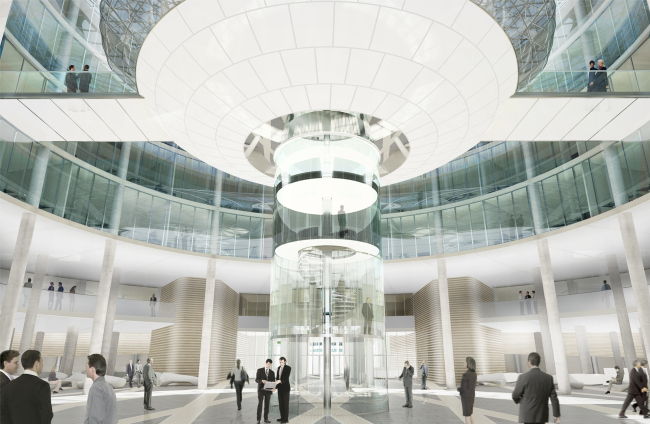
Multi-height atrium
On the other side of the fountain that is located at the inside square of the complex, there is yet another centerpiece - the ten-story business center. In the contest project it had a sheer elliptical shape. Now its outline softened even more - the plan of the building started to look like a frozen drop of water that is about to fall off in the direction of the Degtyarny Alley. This accentuated softness of outlines is in sharp contrast with the pristine geometry of the neighboring office buildings that serve as the framework for the dramatic volume that fixes the new city square. The top often is building is also crowned by the translucent sightseeing platform, while the multicolored glass lamellae form a festive, even a bit too frivolous, architectural image that creates an interesting duo with the building of city administration.

Top view
The positions of the other buildings that run away from the city hall in long beams, had to be slightly altered with regard to the newly discovered architectural monuments. Along the Degtyarny Alley, instead of the initially planned three buildings, only two are there - more elongated rectangular volumes. The rounded building that flanks the corner had to go because this territory now belongs to the existing houses. The changes were also made to the second beam that used to include four large buildings with deep courtyards. Now instead of four buildings there are five, also on the classicist side in their austere "dresses" of natural stone. The corner building has a sophisticated polygon form and is meant to house a hotel. Its neighbors were able to keep the square plans but they are different from the original version with their smaller dimensions and the absence of courtyards. While in the contest proposal the landscaped green territories would be there inside of each building, now only two larger business centers facing the Degtyarny Alley kept their "precinct" courtyards. And this was done not only in token of paying tribute to the architectural traditions of Saint Petersburg: the courtyards successfully solve the problem of insolation in the rather broad buildings.
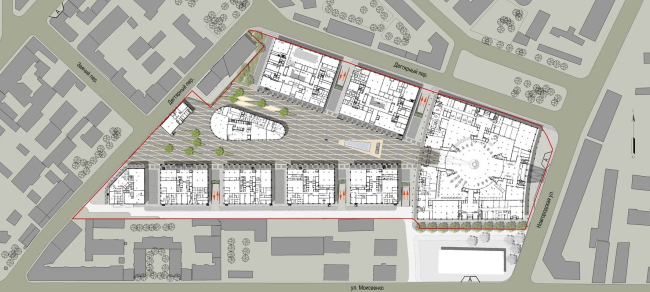
Location plan
It is also worth mentioning that, even with the disappearance of most of the courtyards, this project knows no shortage of public territories: the architects did everything for this complex to be integrated as much as possible into the city fabric and to create new attraction points for the people of Saint Petersburg. Apart from the rather large pedestrian-only central square, and the already-mentioned atrium of the city hall, the public functions are served by a fair bit of first-floor premises - it is planned they they will include cafes, shops, gyms, and so on. And as for the pass-through two-story gallery that runs along the perimeter of the square, in the event of implementation of the second and third phases of construction it will connect these territories into a single pedestrian route. The architects paid almost as much attention to the decoration of the square as they did to the building solutions - because it is this particular space will allow them to make the city hall an integral part of Saint Petersburg and will go a long way to demonstrate the new administration's readiness to enter into a dialogue with the city people.

Administration building courtyard
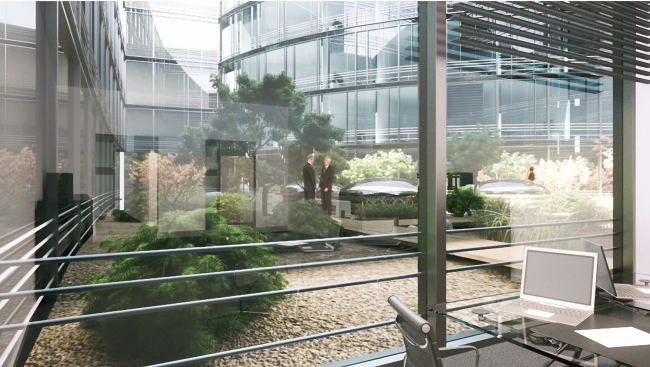


Public and business complex “Nevskaya Ratusha”
Copyright: Photograph © Andrey Belimov-Gushchin, 2025 / provided by SPEECH









